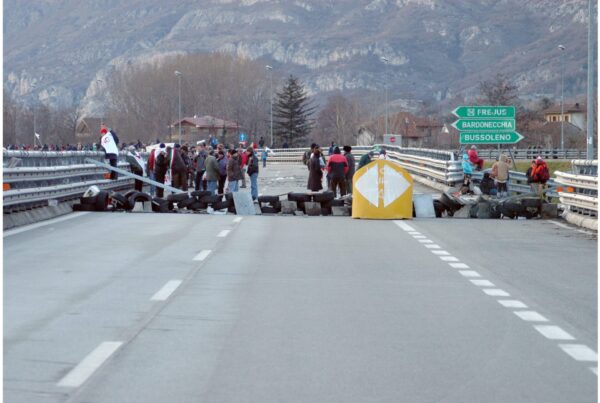By Patrick Bigger and Benjamin Neimark*
Military excursions into low carbon fuels is not a case of military greenwashing but rather one of ‘weaponizing nature’, an approach perpetuating an interventionist US foreign policy linked to environmental change.
If we ever think about the military as environmental actor, it is most likely related to the damage to nature wrought by conflict and war. From nuclear sacrifice zones in the Pacific to neo-imperial wars undertaken in part for control of oil, the most powerful militaries in the world have outsized access to resources and ever-expanding environmental impacts. While political ecologists have helped us understand the environmental causes and consequences of military actions, a path less taken is to look at how militaries understand themselves as environmental actors considering changes in geopolitical and environmental conditions.
In a recent paper published in Political Geography, Weaponizing nature: The geopolitical ecology of the US Navy’s biofuel program, we explore how the US military thinks about climate change, and the concrete actions (economic, environmental, and political) it is taking as a result. While unlikely to foment new conflicts in and of itself, we argue that these conditions will exacerbate conflicts in a global but uneven manner (see Emily Gilbert’s excellent article in ACME). For military officials, these looming challenges range from melting ice that will open the Arctic as a new ‘battle space’, to climate-induced drought that may destabilise entire regions throughout vast swathes of the Global South (DoD 2014 see also: CLICO project results).
To prepare for this dangerous vision of climate change, the US military has undertaken several programs to both mitigate its own carbon ‘bootprint’, and adapt to the new conditions in which it is preparing to intervene. We follow the development of the US Navy’s ‘Great Green Fleet’, a tactical group of warships and aircraft with energy-efficiency retrofits running on a blend of conventional fuels and bespoke, military-grade biofuels produced from algae, crop and timber residues, used cooking oil and inedible beef and chicken fats.
Perhaps unsurprisingly, refineries used to produce these fuels did not exist prior to the Navy’s interest and financial backing. This demonstrates the military’s capacity to intervene in environmentally-tinged commodity markets and infrastructure financing as a conscious environmental-actor that enjoys access to substantial resources and broad public support.

Source: www.cnet.com
Weaponizing nature with military-grade biofuels
To understand the US military as an environmental actor, we develop a conceptual framework that combines the lenses of critical geopolitics and political ecology, which we term ‘geopolitical ecology’ (following Dalby 2016). Our analysis is built upon a three-legged stool that brings geopolitics into explicit dialogue with the two core pillars of political ecology; as foundational political ecology authors Blaikie and Brookfield (1987) put it, ‘the concerns of ecology [and] a broadly defined political economy’. Geopolitical ecology provides an avenue by which to contest multiple forms of received or orthodox knowledge and to critically evaluate the role of very large and powerful geopolitical institutions in environmental change.
We advise against viewing military excursions into low carbon fuels as a case of military greenwashing. Rather, we interpret this initiative as a case of ‘weaponizing nature’, or the use of nature and discourses of environmental change ‘by armed actors to do harm’ (Koopman 2016, p. 530). This framing takes seriously the capacity of the military to produce new socio-natural entanglements for better and worse.
It is no small irony that the US military, the world’s largest single consumer of fossil fuels, has been on the cutting edge of ‘second and third-generation’ biofuels, especially as an explicit strategy to adapt to a changing climate to which it has so significantly contributed. But while decreased greenhouse gas emissions are a nice side effect – the US military has no mandate to reduce its contribution to climate change, or even to report emissions, under the Kyoto Protocol or Paris Agreement – the move to biofuels is primarily about maintaining its power and dominance. That is, the core objective is to secure energy sourcing and provisional flexibility in the context of the ever-shifting military theatres of globally disperse conflict hotspots.

Source: greenfleet.dodlive.mil
Of the Great Green Fleet, former Secretary of the Navy Ray Mabus remarked that, “if you look at the reasons we’re doing it, we’re not doing it to be faddish, we’re not doing it to be green, we’re addressing a specific vulnerability.” Here Mabus referred to the cost, in blood and treasure, of securing fossil fuel supplies and delivering them to front lines. After all, as former Assistant Secretary of State Sharron Burke remarked while discussing the biofuels program, “the job of the military is breaking things and killing people.”
So while it is undoubtedly a positive step that a US military-funded biofuel refinery in Southern California has long-term purchase agreements with United Airlines and feedstocks for lower-carbon fuels are moving away from food crops, there are serious ramifications for making climate change a military competency. This is particularly true in light of a declining appetite for state-supported decarbonization in the US more broadly highlighted not only by President Trump’s decision to pull out of the Paris agreement but a longstanding support for the ailing coal industry.
So rather than fossil fuel lock-in, this weaponized nature is predicated on, and perpetuates, an interventionist US foreign policy linked to environmental change. By attempting to decouple itself from existing energy geographies, which overlap to a large degree with US military actions, a move toward biofuels enables US intervention to a larger degree in new spaces. These spaces, according to military planning, are likely to be those most impacted by global warming. This reality heaps the spectacular violence of US military intervention on top of the slow violence of environmental change for which the US is disproportionately culpable.

Source: www.biofuelsdigest.com
The politics of geopolitical ecology
We hope that geopolitical ecology may be useful for both academics and activists. It provides ground for scholars to observe the military’s political, economic, and environmental role in shaping the terms of debate around climate change, and what kinds of futures are desirable, or even possible. There are already examples of this approach, such as Chaturverdi and Doyle’s compelling Climate Terror, but given the capacity for militaries to make and remake economies and environments, there is certainly room for more.
For both green and anti-war activists, the US military must be held accountable for large-scale environmental change part and parcel of military operations. Not since the nuclear disarmament movement in the 1980s has there been any largescale movement that constitutes such an alliance between these two groups in the US. In a time of rising geopolitical hostilities and temperatures, both driven in large part by the United States, it is critical we develop analytical approaches and political movements that make the discursive and material connections – an approach for which political ecology is well suited.
*Patrick Bigger is a lecturer of critical human geography at Lancaster University, UK. His research primarily focuses on financial practices for managing environmental change, including carbon trading, green debt, and private equity for biodiversity conservation, in addition to military interventions into green fuel markets. He was previously a post-doctoral fellow in the European Network for Political Ecology at Manchester University, where much of the work presented above was undertaken.
Benjamin Neimark is a lecturer of human geography and political ecology at Lancaster University, UK. His varied research and teaching interests include the political economy of green and bio-economies, critical development studies, labour regimes, resource extraction, social justice, commodity chains, and agrarian change, with a regional focus on Africa and Madagascar.






Reblogged this on A Left Libertarian Writes and commented:
Interesting piece on the weaponisation of nature and the military’s use of renewable and alternative energy sources.